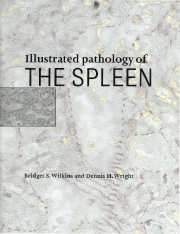Book contents
- Frontmatter
- Contents
- Preface
- Acknowledgements
- 1 Introduction
- 2 Normal structure, development and functions of the spleen
- 3 Post-traumatic and incidentally removed spleens
- 4 The spleen in hereditary blood cell abnormalities and auto-immune disorders
- 5 The spleen in immunodeficiency and systemic infections
- 6 Lymphomas involving the spleen
- 7 The spleen in myeloproliferative disorders
- 8 Pathology of the splenic stroma
- 9 Metastases and miscellaneous conditions
- 10 Summary: some key points in splenic differential diagnosis
- Index
1 - Introduction
Published online by Cambridge University Press: 14 August 2009
- Frontmatter
- Contents
- Preface
- Acknowledgements
- 1 Introduction
- 2 Normal structure, development and functions of the spleen
- 3 Post-traumatic and incidentally removed spleens
- 4 The spleen in hereditary blood cell abnormalities and auto-immune disorders
- 5 The spleen in immunodeficiency and systemic infections
- 6 Lymphomas involving the spleen
- 7 The spleen in myeloproliferative disorders
- 8 Pathology of the splenic stroma
- 9 Metastases and miscellaneous conditions
- 10 Summary: some key points in splenic differential diagnosis
- Index
Summary
Why is splenectomy performed?
Splenectomy is frequently incidental, performed because of technical necessity in gaining adequate surgical access to the stomach, left side of the colon, left kidney or aorta. Under these circumstances, there may be no distinctive pathology present related to the primary cause for surgery. However, such spleens may not be absolutely normal, and it can be difficult to decide with confidence what are acceptable secondary reactive changes and what might constitute significant co-existent splenic pathology.
Splenectomy may also be performed primarily for therapy. This is obviously the case when the spleen is ruptured following abdominal trauma, a potentially life-threatening situation. It is important to know that splenectomy may none the less be delayed for hours or even days following the traumatic event, since haemorrhage from a damaged spleen does not always occur immediately after the injury, may be minor, or may cause relatively slow development of an intra-abdominal haematoma. Even after a delay of a few hours following the initial injury, changes may be present in the spleen as a response to the injury. Since, in some cases, splenic rupture may follow mild trauma because the organ is abnormal, it is important to know whether any changes present are the result, or part of the cause, of splenic injury.
Splenectomy of a primarily therapeutic nature is also performed for hypersplenism, most commonly because of excessive red cell destruction in auto-immune haemolytic anaemia (AIHA) or platelet destruction in idiopathic thrombocytopenic purpura (ITP).
- Type
- Chapter
- Information
- Illustrated Pathology of the Spleen , pp. 1 - 12Publisher: Cambridge University PressPrint publication year: 2000
- 1
- Cited by



